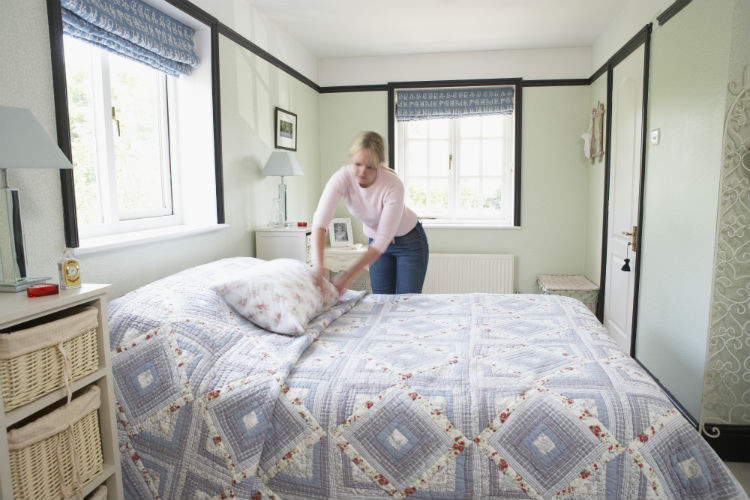While change is difficult for people of all ages, deviating from the status quo seems to become even more taxing as we get older and more set in our ways. Yet it’s often our elders who are forced to make the most dramatic lifestyle changes.
One example is downsizing to assisted living from a family home or condominium. Not only do our loved ones have to leave the familiar environments they are used to, but they must also accept the fact that advancing age and/or increasing health needs necessitate this move.
How to Make an Assisted Living Apartment Feel Like Home
Moving to an assisted living facility (ALF) is a lot to ask of an aging loved one. Most wish to remain in the comfort of their own homes surrounded by memories and personal belongings. But when their care needs increase, the safety, assistance and social interaction that assisted living communities offer usually prevail over a senior’s desire for familiarity. This transition is challenging for older adults and their family caregivers, but a few simple steps can help a loved one feel more at peace with the idea and accepting of their new home.
Respect Their Perspective
It’s important to understand that your thoughts on this transition are likely very different from those of your aging loved one. You see this move as a positive change that will provide your parent(s) with nutritious meals, on-site care services, social opportunities, transportation and much more. But to your parent(s), this move represents a significant loss. Even if they are leaving an older, deteriorating home for a sparkling new assisted living facility, they are leaving behind a good deal of their past. This move is an acknowledgement of their fleeting independence.
Yes, many seniors do recognize and appreciate the countless benefits that assisted living has to offer, but the move itself is still bittersweet. Just be mindful of your loved one’s complex feelings throughout this whole process.
Handle Downsizing Tactfully
It is one thing to move to a new, comparatively sized home, but it is quite another to have to purge much of one’s belongings or put them in storage. This is often the case when seniors transition from a large family home or condo to a one-bedroom apartment or studio in assisted living. Sifting through a parent’s personal effects can be a long process that requires plenty of patience.
The best way to start is by asking them what personal belongings they feel strongest about keeping. With a little effort, you can incorporate some of these things into their new assisted living room, offer to store some possessions, or ensure keepsakes stay within the family by passing them on to other relatives. Space in their new home will likely be limited, so letting them know that you’ll help store or rehome things they don’t use on a daily basis should ease some of their grief over having to part with much of their tangible history.
Furnishing and Decorating an Assisted Living Room
Accurate measurements of a senior’s new apartment are the best guide to determining exactly what your loved one can bring with them, what must be stored, given away, donated or purged, and what can be purchased new. The goal is to create a personalized, functional and comfortable space for them to call their own.
If they can furnish their own assisted living room, prioritize bringing along their favorite armchair for watching television or reading as long as it’s in decent shape. If there is room for a dresser, let them bring theirs from home. If they have a grandfather clock that’s been in the family for years, try your best to find a place for it. Helping them bring as many mementos from home as they can will ease the transition. Just be sure to avoid cluttering the space and using furniture arrangements that are difficult to navigate.
Make a priority of finding shelving, a cabinet or a hutch for them to store and display photos, books, awards, collectibles and other life treasures in a safe and accessible way. This will add a sophisticated, personalized touch to their space. Cherished photographs and pieces of art can also be displayed on the walls.
Add cozy touches to the main living areas, such as throw pillows, a quilt or blanket, and curtains, if possible. Ensure they have comfortable pillows and linens for their bed, too. Even if they do want new things, save a few of the old pieces if they’re still in good condition. You never know when Mom will decide she liked her old bedspread better and want it back.
Keep in mind that some elders do jump at the chance to purchase new bedding or furniture when they move to assisted living. A new couch, flat screen TV, comfy recliner, or bedding set can signify a fresh start in their new home. Although this isn’t the norm, if your mom or dad wants to buy new items, indulge them as long as the costs are reasonable. It’s their home and they should choose how it is decorated.
Understand What Is Important to Your Loved One
Take a moment to think about what brings your loved one joy. What aspects of their house, no matter how small, would they like to bring with them to assisted living?
For example, regardless of where he lived, my uncle was always particular about having a comfortable chair available for his visitors to sit in. My mom was determined to be a good hostess and always offered food or drinks to her guests. Even my dad, deep in his dementia, needed his candy basket full so he had something to offer family, aides and fellow residents when they stopped by his nursing home room.
I knew these things about my loved ones, so I did what I could to provide what they needed to properly ‘host’ friends in their residential care environment. Being able to offer comfort and/or a treat to visitors helps our elders retain more of their dignity and a sense of control over their own space.
Give Them Time to Warm Up to Their New Home
Don’t force a senior to dive right into the activities and social events at their assisted living community. A good facility will have a welcome routine for new residents, but it can take them a few weeks or even months to adjust before they begin to take full advantage of all the ALF has to offer.
When you speak with them, refer to their new apartment or room as their home. Assisted living apartments and even small nursing home rooms are home to the people who live there. Your aim is to help them feel a sense of belonging, so your language and attitude will make a difference.
Your elder will go through a sort of grieving process over the loss of their home and a perceived loss of independence, so try not to be disappointed when they complain about the facility. Don’t expect gratitude. Treat them with respect and don’t rush them into accepting and appreciating all these changes immediately. Many older adults eventually realize that assisted living is a setting that extends their independence and simplifies their everyday life once they begin to get involved and establish new routines.
However, if they still seem unhappy or angry about the move after they have spent a few weeks living in their new home, talk with their doctor about possible depression. Likely, if you give them time to adjust and you work with staff there, you’ll find that they may grow to love the safety, warmth and friendship a good assisted living facility offers.

